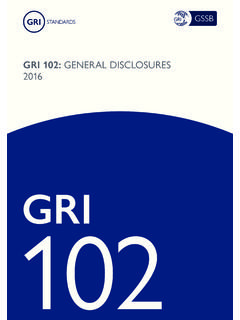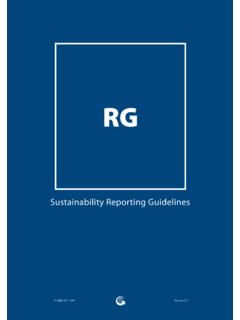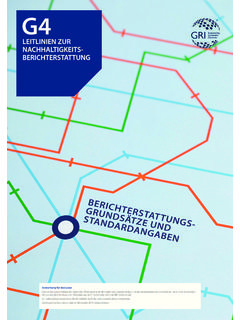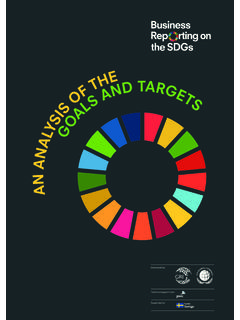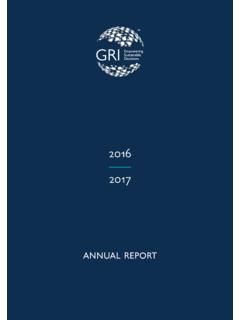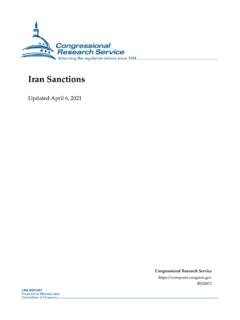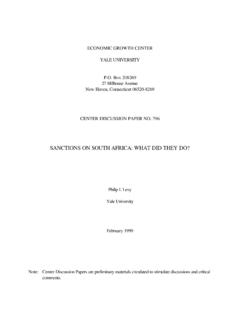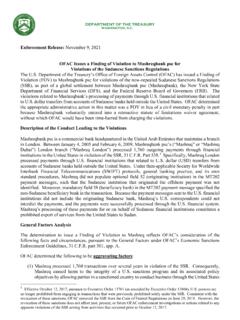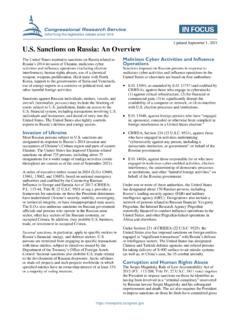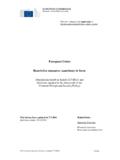Transcription of GRI 419: SOCIOECONOMIC COMPLIANCE 2016
1 GRI 419: SOCIOECONOMIC COMPLIANCE 2016 GRI 4192 GRI 419: SOCIOECONOMIC COMPLIANCE 2016 ContentsIntroduction 3 GRI 419: SOCIOECONOMIC COMPLIANCE 51. Management approach disclosures 52. Topic-specific disclosures 6 Disclosure 419-1 Non- COMPLIANCE with laws and regulations in the social and economic area 6 Glossary 7 References 8 ResponsibilityThis Standard is issued by the Global Sustainability Standards Board (GSSB). Any feedback on the GRI Standards can be submitted to for the consideration of the GSSB. ScopeGRI 419: SOCIOECONOMIC COMPLIANCE sets out reporting requirements on the topic of SOCIOECONOMIC COMPLIANCE . This Standard can be used by an organization of any size, type, sector or geographic location that wants to report on its impacts related to this referencesThis Standard is to be used together with the most recent versions of the following 101: FoundationGRI 103: Management Approach GRI Standards GlossaryIn the text of this Standard, terms defined in the Glossary are dateThis Standard is effective for reports or other materials published on or after 1 July 2018.
2 Earlier adoption is this Standard Note: This document includes hyperlinks to other Standards. In most browsers, using ctrl + click will open external links in a new browser window. After clicking on a link, use alt + left arrow to return to the previous 419: SOCIOECONOMIC COMPLIANCE 2016A. Overview This Standard is part of the set of GRI Sustainability Reporting Standards (GRI Standards). These Standards are designed to be used by organizations to report about their impacts on the economy, the environment, and GRI Standards are structured as a set of interrelated, modular standards. The full set can be downloaded at There are three universal Standards that apply to every organization preparing a sustainability report:GRI 101: FoundationGRI 102: General DisclosuresGRI 103: Management Approach An organization then selects from the set of topic-specific GRI Standards for reporting on its material topics. These Standards are organized into three series: 200 ( economic topics), 300 (Environmental topics) and 400 (Social topics).
3 Each topic Standard includes disclosures specific to that topic, and is designed to be used together with GRI 103: Management Approach, which is used to report the management approach for the Using the GRI Standards and making claims There are two basic approaches for using the GRI Standards. For each way of using the Standards there is a corresponding claim, or statement of use, which an organization is required to include in any published materials. 1. The GRI Standards can be used as a set to prepare a sustainability report that is in accordance with the Standards. There are two options for preparing a report in accordance (Core or Comprehensive), depending on the extent of disclosures included in the report. An organization preparing a report in accordance with the GRI Standards uses this Standard, GRI 419: SOCIOECONOMIC COMPLIANCE , if this is one of its material Selected GRI Standards, or parts of their content, can also be used to report specific information, without preparing a report in accordance with the Standards.
4 Any published materials that use the GRI Standards in this way are to include a GRI-referenced 419: SOCIOECONOMIC COMPLIANCE is a topic-specific GRI Standard in the 400 series (Social topics).GRI 101: Foundation is the starting point for using the GRI Standards. It has essential information on how to use and reference the Section 3 of GRI 101: Foundation for more information on how to use the GRI Standards, and the specific claims that organizations are required to include in any published materials. GRI 103 GRI 102 Topic-specificStandardsUniversal StandardsStarting point for using the GRI StandardsGRI 101 FoundationGeneral DisclosuresManagement ApproachTo report contextual information about an organizationTo report the management approach for each material topicSelect from these to report specific disclosures for each material topicGRI 300 EnvironmentalGRI 400 SocialGRI 200 EconomicFigure 1 Overview of the set of GRI Standards4 GRI 419: SOCIOECONOMIC COMPLIANCE 2016C. Requirements, recommendations and guidance The GRI Standards include: Requirements.
5 These are mandatory instructions. In the text, requirements are presented in bold font and indicated with the word shall . Requirements are to be read in the context of recommendations and guidance; however, an organization is not required to comply with recommendations or guidance in order to claim that a report has been prepared in accordance with the These are cases where a particular course of action is encouraged, but not required. In the text, the word should indicates a recommendation. Guidance. These sections include background information, explanations and examples to help organizations better understand the organization is required to comply with all applicable requirements in order to claim that its report has been prepared in accordance with the GRI Standards. See GRI 101: Foundation for more Background context In the context of the GRI Standards, the social dimension of sustainability concerns an organization s impacts on the social systems within which it I 419 addresses the topic of SOCIOECONOMIC COMPLIANCE .
6 This includes an organization s overall COMPLIANCE record, as well as COMPLIANCE with specific laws or regulations in the social and economic area. COMPLIANCE can relate to accounting and tax fraud, corruption, bribery, competition, the provision of products and services, or labor issues, such as workplace discrimination, among others. This includes COMPLIANCE with international declarations, conventions, and treaties, as well as national, sub-national, regional, and local concepts are covered in key instruments of the Organisation for economic Co-operation and Development: see disclosures in this Standard can provide information on an organization s COMPLIANCE with applicable laws and regulations, and with other disclosures that relate to this topic can also be found in: GRI 307: Environmental ComplianceIf the reporting organization has identified both topics as material, it can combine its disclosures for GRI 307 and GR I 419. For example, if the organization uses the same approach for managing both topics, it can provide one combined explanation of its management 419: SOCIOECONOMIC COMPLIANCE 2016 This Standard includes disclosures on the management approach and topic-specific disclosures.
7 These are set out in the Standard as follows: Management approach disclosures (this section references GRI 103) Disclosure 419-1 Non- COMPLIANCE with laws and regulations in the social and economic areaReporting The reporting organization shall report its management approach for SOCIOECONOMIC COMPLIANCE using GRI 103: Management 419: SOCIOECONOMIC Compliance1. Management approach disclosuresManagement approach disclosures are a narrative explanation of how an organization manages a material topic, the associated impacts, and stakeholders reasonable expectations and interests. Any organization that claims its report has been prepared in accordance with the GRI Standards is required to report on its management approach for every material topic, as well as reporting topic-specific disclosures for those , this topic-specific Standard is designed to be used together with GRI 103: Management Approach in order to provide full disclosure of the organization s impacts.
8 GRI 103 specifies how to report on the management approach and what information to 419: SOCIOECONOMIC COMPLIANCE 2016 Disclosure 419-1 Non- COMPLIANCE with laws and regulations in the socialand economic area2. Topic-specific disclosures Reporting requirements419-1 DisclosureReporting When compiling the information specified in Disclosure 419-1, the reporting organization should include administrative and judicial sanctions for failure to comply with laws and/or regulations in the social and economic area, including: international declarations, conventions, and treaties; national, sub-national, regional, and local regulations; cases brought against the organization through the use of international dispute mechanisms or national dispute mechanisms supervised by government for Disclosure 419-1 Relevant information for this disclosure can include data as reported with GRI 416: Customer Health andSafety and GRI 417: Marketing and within an organization can indicate the ability of management to ensure that operations conform to certain performance parameters.
9 In some circumstances, non- COMPLIANCE can lead to remediation obligations or other costly liabilities. The strength of an organization s COMPLIANCE record can also affect its ability to expand operations or gain reporting organization shall report the following information:a. Significant fines and non-monetary sanctions for non- COMPLIANCE with laws and/or regulations in the social and economic area in terms of: i. total monetary value of significant fines; ii. total number of non-monetary sanctions ; iii. cases brought through dispute resolution If the organization has not identified any non- COMPLIANCE with laws and/or regulations, a brief statement of this fact is The context against which significant fines and non-monetary sanctions were 419: SOCIOECONOMIC COMPLIANCE 2016 GlossaryThis Glossary includes definitions for terms used in this Standard, which apply when using this Standard. These definitions may contain terms that are further defined in the complete GRI Standards Glossary.
10 All defined terms are underlined. If a term is not defined in this Glossary or in the complete GRI Standards Glossary, definitions that are commonly used and understood the GRI Standards, unless otherwise stated, impact refers to the effect an organization has on the economy, the environment, and/or society, which in turn can indicate its contribution (positive or negative) to sustainable development. Note 1: In the GRI Standards, the term impact can refer to positive, negative, actual, potential, direct, indirect, short-term, long-term, intended, or unintended 2: Impacts on the economy, environment, and/or society can also be related to consequences for the organization itself. For example, an impact on the economy, environment, and/or society can lead to consequences for the organization s business model, reputation, or ability to achieve its topictopic that reflects a reporting organization s significant economic , environmental and social impacts; or that substantively influences the assessments and decisions of stakeholders Note 1: For more information on identifying a material topic, see the Reporting Principles for defining report content in GRI 101: Foundation.
